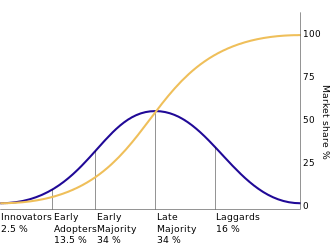Rogers' Diffusion of Innovation is a model that illustrates the relationship between time (X Axis) and market penetration of a given product or idea (Y Axis). The amount of time, of course, varies per item as does the market it is in, for example: the USA, USA teenagers, the world, ext.).
Typically, Penetration/ Market Share will max out around 85%. However, for some technologies, such as the cellphone in America, there is a whooping 97% market penetration with 85% if US citizens having a "smart phone", 11% having a cellphone that is not a smartphone. And then the remaining 3% that don't have a cellphone. (Although I speculate that 2% of the 3% of Americans who don't have a cellphone have a landline). SOURCE: Pew Research Center.
When it comes to talking about the telephone concerning the Diffusion of Innovation Model... it it had a much slower adoption rate than many technologies we are seeing today. For example, the iPhone was $499 (637.47 adjusted for inflation) when it was initially released meaning it was much more affordable than the telephone when it was first released. "In 1915, a three-minute daytime phone call from New York City to San Francisco cost $20.70. Adjusted for inflation, that means the rather abrupt call cost more than $500 in today’s money." (The Conversation) With both adjusted for inflation, you could either make a 5 minute phone call in 1915, or buy a smartphone in 2007!
And this discrepancy becomes even more telling when we talk about innovations such as social media because they are entirely free to use. The cheaper innovations are, the faster they are going to penetrate their market because greater scale does not result in a cheaper product for either the consumer or the producer. This all goes to say that price is a factor to the consumer in some inventions (the cell phone, for example) but not in others (Facebook, because it's free to use).
Specifically concerning the Telephone invented by Alexander Bell in 1876, it's a little hard to pin point specific dates, especially now a days that telephone statistics are usually convoluted / effected by cellphone penetration and the fact that before cellphones, often times families would share telephones (because they were stationary in houses. However, according to some data I found on Statista, 50% of American households had accesses to a telephone in between 1940 and 1950 and this figure quickly jumped to 90% by 1970. With this said, I would place the tipping point around 1945, and market saturation around 1990 since after that there was little to no more growth.
Information Sources:
Image Sources:





Comments
Post a Comment